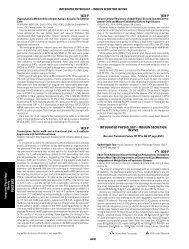Mechanisms for the Deterioration in Glucose Tolerance ... - Diabetes
Mechanisms for the Deterioration in Glucose Tolerance ... - Diabetes
Mechanisms for the Deterioration in Glucose Tolerance ... - Diabetes
Create successful ePaper yourself
Turn your PDF publications into a flip-book with our unique Google optimized e-Paper software.
PROTEASE INHIBITOR–INDUCED GLUCOSE INTOLERANCE<br />
TABLE 2<br />
Body composition, viral load, and CD 4 counts<br />
Basel<strong>in</strong>e 12 weeks<br />
P vs.<br />
basel<strong>in</strong>e<br />
BMI (kg/m 2 )<br />
NRTI pretreated 29.7 2.1 29.9 1.7 0.93<br />
NRTI naïve 26.7 1.6 27.3 2.6 0.92<br />
Both 29.0 1.8 28.9 1.5 0.81<br />
Normal volunteers 28.2 0.8<br />
P vs. groups<br />
Lean body mass (kg)<br />
0.34<br />
NRTI pretreated 56.4 3.8 55.9 3.6<br />
NRTI naïve 58.9 3.1 60.5 4.0<br />
Both 57.4 2.6 57.7 2.7 0.69<br />
Normal volunteers 60.1 4.9<br />
P vs. groups<br />
Body fat (kg)<br />
0.62<br />
NRTI pretreated 33.0 5.6 33.2 5.5<br />
NRTI naïve 16.5 2.9 18.2 3.0<br />
Both 26.7 4.9 27.4 4.0 0.03<br />
Normal volunteers 23.2 2.6<br />
P vs. groups 0.048<br />
CD4 counts<br />
NRTI pretreated 393 50<br />
NRTI naïve 311 51<br />
Both 361 37<br />
P vs. groups<br />
Viral load<br />
0.73<br />
NRTI pretreated 3638 1588 256 119 0.001<br />
NRTI naïve 2814 1267 511 205 0.001<br />
Both 3321 1060 355 108 0.001<br />
P vs. groups 0.82<br />
Data are means SD.<br />
RESULTS<br />
Body composition, waist-to-hip ratio, viral loads, and<br />
CD 4 counts<br />
Basel<strong>in</strong>e characteristics of <strong>the</strong> groups did not differ except<br />
that <strong>the</strong> NRTI-naïve subjects had lower <strong>in</strong>itial body fat.<br />
Dur<strong>in</strong>g 12 weeks of treatment, BMI, total body fat, and lean<br />
body mass did not change <strong>in</strong> ei<strong>the</strong>r group; viral load<br />
decreased by 80% <strong>in</strong> both groups (P 0.001) (Table 2).<br />
HbA 1c, fast<strong>in</strong>g plasma glucose, <strong>in</strong>sul<strong>in</strong>, glucagon, Cpeptide,<br />
pro<strong>in</strong>sul<strong>in</strong>, glycerol, FFAs, and plasma lipids<br />
Basel<strong>in</strong>e values, which were comparable with those of <strong>the</strong><br />
normal volunteers, and responses dur<strong>in</strong>g treatment <strong>in</strong><br />
NRTI-pretreated and NRTI-naïve groups were not significantly<br />
different (Tables 3 and 4).<br />
After 12 weeks of treatment, fast<strong>in</strong>g plasma glucose<br />
<strong>in</strong>creased <strong>in</strong> all subjects (P 0.001). Fast<strong>in</strong>g plasma<br />
<strong>in</strong>sul<strong>in</strong> also <strong>in</strong>creased (P 0.001). In contrast, fast<strong>in</strong>g<br />
plasma C-peptide and pro<strong>in</strong>sul<strong>in</strong> did not change (both P <br />
0.61). Consequently, both <strong>the</strong> plasma C-peptide–to–<strong>in</strong>sul<strong>in</strong><br />
ratio and <strong>the</strong> plasma pro<strong>in</strong>sul<strong>in</strong>–to–<strong>in</strong>sul<strong>in</strong> ratio decreased<br />
(both P 0.007). The plasma C-peptide–to–pro<strong>in</strong>sul<strong>in</strong><br />
ratio and plasma glucagon rema<strong>in</strong>ed unchanged (P 0.59<br />
and 0.69, respectively).<br />
Fast<strong>in</strong>g plasma glycerol <strong>in</strong>creased (P 0.02), whereas<br />
plasma FFAs, triglycerides, and total and HDL cholesterol<br />
rema<strong>in</strong>ed unchanged (all P 0.13). However, plasma LDL<br />
cholesterol <strong>in</strong>creased slightly but significantly (P 0.03).<br />
-Cell function and <strong>in</strong>sul<strong>in</strong> sensitivity<br />
HOMA. Basel<strong>in</strong>e values and responses to treatment were<br />
not significantly different <strong>in</strong> NRTI-pretreated and NRTI-<br />
TABLE 3<br />
HbA 1c, fast<strong>in</strong>g plasma glucose, <strong>in</strong>sul<strong>in</strong>, glucagon, C-peptide, and<br />
pro<strong>in</strong>sul<strong>in</strong><br />
Be<strong>for</strong>e 12 weeks<br />
P vs.<br />
basel<strong>in</strong>e<br />
HbA1c (%)<br />
NRTI pretreated 5.5 0.3 —<br />
NRTI naïve 5.8 0.3 —<br />
Both 5.6 0.2 —<br />
Normal volunteers 5.8 0.3<br />
P vs. groups<br />
<strong>Glucose</strong> (mmol/l)<br />
0.91<br />
NRTI pretreated 4.58 0.23 5.36 0.13<br />
NRTI naïve 4.87 0.25 5.69 0.14<br />
Both 4.69 0.11 5.49 0.11 0.001<br />
Normal volunteers 4.96 0.11<br />
P vs. groups<br />
Plasma <strong>in</strong>sul<strong>in</strong> (pmol/l)<br />
0.59<br />
NRTI pretreated 108 17 125 17<br />
NRTI naïve 61 12 87 9<br />
Both 90 13 111 11 0.001<br />
Normal volunteers 72 12<br />
P vs. groups<br />
Plasma glucagon (pg/ml)<br />
0.08<br />
NRTI pretreated 80 4 805 NRTI naïve 78 7 713 Both 79 3 7740.69 Normal volunteers 70 6<br />
P vs. groups<br />
Plasma C-peptide (nmol/l)<br />
0.98<br />
NRTI pretreated 0.77 0.13 0.73 0.08<br />
NRTI naïve 0.51 0.09 0.61 0.06<br />
Both 0.67 0.09 0.68 0.05 0.84<br />
Normal volunteers 0.54 0.06<br />
P vs. groups<br />
Plasma pro<strong>in</strong>sul<strong>in</strong> (pmol/l)<br />
0.34<br />
NRTI pretreated 13.3 2.1 13.0 1.9<br />
NRTI naïve 11.1 1.6 12.0 1.4<br />
Both 12.4 1.4 12.6 1.2 0.61<br />
Normal volunteers 12.0 1.6<br />
P vs. groups 0.87<br />
Data are means SD.<br />
naïve subjects. At basel<strong>in</strong>e, both groups had comparable<br />
<strong>in</strong>sul<strong>in</strong> sensitivity and -cell function with those of normal<br />
volunteers. After 12 weeks of treatment, both <strong>in</strong>sul<strong>in</strong><br />
sensitivity and pancreatic -cell function decreased significantly<br />
(P 0.002 and 0.003, respectively) (Tables 5 and 6<br />
and Fig. 1).<br />
Hyperglycemic clamp experiments<br />
Insul<strong>in</strong> sensitivity. Plasma glucose, <strong>in</strong>sul<strong>in</strong>, C-peptide,<br />
and pro<strong>in</strong>sul<strong>in</strong> concentrations and glucose <strong>in</strong>fusion rates<br />
are given <strong>in</strong> Fig. 1. Plasma glucose levels were not significantly<br />
different <strong>in</strong> clamps per<strong>for</strong>med at basel<strong>in</strong>e and 12<br />
weeks <strong>in</strong> all groups. The <strong>in</strong>sul<strong>in</strong> sensitivity <strong>in</strong>dex calculated<br />
by divid<strong>in</strong>g <strong>the</strong> glucose <strong>in</strong>fusion rates by <strong>the</strong> product<br />
of plasma glucose and <strong>in</strong>sul<strong>in</strong> concentrations were comparable<br />
with those of <strong>the</strong> normal volunteers, and responses<br />
to treatment were not significantly different <strong>in</strong><br />
NRTI-pretreated and NRTI-naïve subjects. The <strong>in</strong>sul<strong>in</strong> sensitivity<br />
<strong>in</strong>dex decreased significantly after treatment (P <br />
0.001).<br />
-Cell function. At basel<strong>in</strong>e, both first- and second-phase<br />
<strong>in</strong>sul<strong>in</strong> release was normal <strong>in</strong> both patient groups. After<br />
treatment, first-phase <strong>in</strong>sul<strong>in</strong> release decreased signifi-<br />
920 DIABETES, VOL. 52, APRIL 2003
















